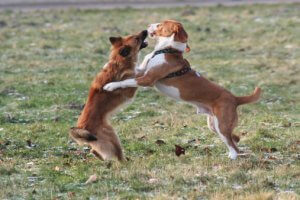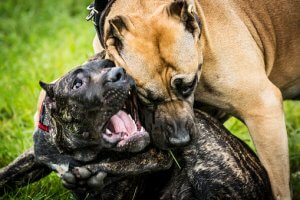Dog bites are among the most common veterinary emergencies. Your dog could experience a dog fight at a dog park, doggy daycare, a walk, or at a friend’s house. If your dog is attacked by another dog, it can be a scary and chaotic experience for you and your dog.
To help you respond appropriately, the Animal Medical Center of Streetsboro has put together a guide on what to do if your dog is bitten.
Avoid Standing in Between the Fighting Dogs
 While it is normal to want to step in between the dogs and protect your pet at all costs, it is not safe to do so. This is because the other dog could also attack and seriously injure you.
While it is normal to want to step in between the dogs and protect your pet at all costs, it is not safe to do so. This is because the other dog could also attack and seriously injure you.We recommend that if your dog is leashed at the time of the attack, use the leash to pull your dog away while staying a safe distance from the dog. If this doesn’t work or isn’t possible, you can try to spray them with water from a bottle or hose to startle them and move them apart.
Try to Remain Calm
While this is easier said than done, it’s crucial to keep a level head in this type of situation so you can properly care for your dog. Your dog may pick up on your stressed emotions, escalating the situation.
We recommend that you try to distract and break up the dogs calmly. Never be aggressive toward the other dog or its owner because it can escalate the situation and cause their dog to attack you.
Exchange Information with the Dog Owner
Before leaving the scene of the incident, be sure to calmly exchange any relevant details with the other dog owner. You both need to gather information such as:
- Name of the dog owner and any witnesses
- Address of the dog owner
- Contact information of the dog owner and any witnesses
- The vaccination records of the other dog. You especially need their rabies vaccination status
- Description of the dog who attacked your dog. This includes the size, breed, color, and other physical attributes
- Photos of your dog and your dog’s injuries
Carefully Examine Your Dog’s Injuries
Your dog may act aggressively after this traumatic event. Be sure to move slowly and speak softly while tending to your dog. Gently assess their wounds and hold pressure to any that are actively bleeding. Do not allow them to walk independently until the bleeding stops. When they do walk, observe their gait and see if they are limping or have any limb injuries. If needed, be sure to carry your dog to prevent further injury.
Take Your Dog to the Veterinarian
Even if your dog is not visibly injured, it should still be examined by a veterinarian. They could have puncture wounds underneath their fur or another injury that you can’t see. It’s also important to remember that teeth puncture wounds can be much deeper than they look. Some severe wounds can even penetrate your dog’s abdominal cavity or chest.
Additionally, bite wounds tend to become infected when not cleaned properly. Depending on how badly injured your dog is, they may need pain medicine or antibiotics.
Should I Take My Dog to The Emergency Vet?
 You need to take your dog to the veterinary ER if they are experiencing ongoing bleeding or bleeding that occurs with every heartbeat/spurting. They should also go to the ER if they have bite or puncture wounds along their chest, neck, or abdomen or if they are vocalizing.
You need to take your dog to the veterinary ER if they are experiencing ongoing bleeding or bleeding that occurs with every heartbeat/spurting. They should also go to the ER if they have bite or puncture wounds along their chest, neck, or abdomen or if they are vocalizing.You can take them to urgent veterinary care if they have signs of pain, limping, or visible wounds with no active bleeding. If they have no visible wounds or signs of pain or distress, you can wait for an appointment with your primary veterinarian.
We recommend calling ahead and explaining your dog’s condition to see what is best for them.
How To Care for Your Dog After An Attack
After you’ve visited the veterinarian, be sure to follow all of your veterinarian’s instructions. Depending on their injuries, your dog’s activity may be restricted to ensure they heal properly. Ensure your dog finishes their medications and does not stop taking them until they have finished the recommended course.
You also want to monitor your dog, preventing them from biting, licking, or scratching its wounds. If necessary, you may need to get an e-collar to prevent them from contaminating or further damaging their injured areas. You also want to ensure you take your dog in for a follow-up so your veterinarian can check their healing progress and remove any drains or sutures.
It’s almost important to remember that your dog may be traumatized after the attack and exhibit behavioral issues. Signs of emotional trauma in dogs include:
- Defensive behavior toward other dogs, such as arching their back, growling, or snarling
- Increased separation anxiety
- Lack of desire to play and interact with other dogs
If your dog behaves like this, it’s crucial to get them medical attention. If they are left untreated, they could become a danger to other dogs, people, and themselves. You may need to take them to a behavioral specialist to help retrain your dog.
Has Your Dog Been Injured by Another Dog? We Can Help!
Contact the veterinary experts at Animal Medical Center of Streetsboro today to learn more about caring for your dog after an attack and how we can help nurse your pet back to health.

